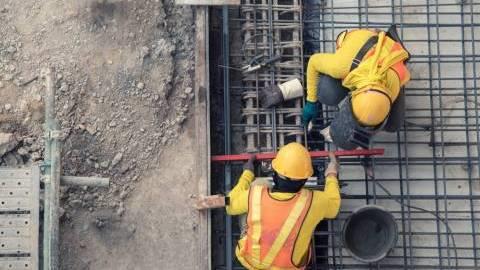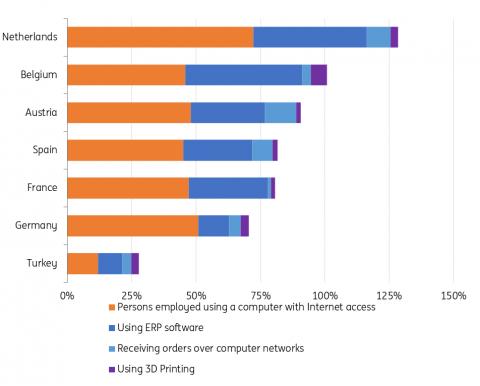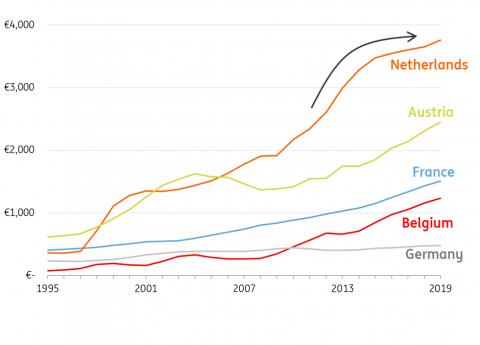
Digitalisation must be top priority for construction companies
The construction sector is catching up when it comes to digitalisation, but not all firms are on board
In this article- What is digital construction?
- Digitisation: from 'paper' to computer
- Digitalisation: Optimising business processes with digital information
- Digital transformation: a new business model
- Advantages of digitalisation
- Hurdles for digitalisation
- The current status of digital construction
- Digital construction is catching up due to mobile internet
- Dutch building firms are frontrunners
- Deceleration of digitalisation pace looms
- Second phase of digitalisation is more difficult
- Digitalisation can make the difference

Share
Download article as PDF
NewsletterStay up to date with all of ING's latest economic and financial analysis.
Subscribe to THINK What is digital construction?A recently published EU working document states:“Digitalisation is a means, an enabler to achieve a better built environment for the planet and people”. In this article, we focus on how digitalisation can fuel contractors to improve the building process. (Technologies that give buildings extra user options – smart buildings – are out of scope.) To explain what digital construction exactly is and how it can help construction companies to be more efficient, we distinguish three phases:
Three phases of digital construction*ING Research
*When we use the word“digitalisation” in general form in this article, we mean all these three phases together. 1 Digitisation: from 'paper' to computer
Digitisation converts information into a digital form. For example, construction drawings are digitised (known as BIM: Building Information Modeling), photos of building issues are saved digitally, and the use of sensors makes information digital. Digitised information is exchanged via WhatsApp, email, SharePoints and (video) calling, but using computers doesn't lead to new applications during this phase (see box below). The efficiency gains are therefore still limited. Construction drawings, for example, are digital but not everyone has the latest version automatically at their disposal (SSOT: Single Source of Truth). In this phase, staff have all kinds of digital information, but must examine the data themselves.
2 Digitalisation: Optimising business processes with digital informationIn the next phase of digitalisation, digitised information is used to make business processes more efficient. Digital information (from sensors, drones, photos and construction drawings) is converted into data. This (big) data can be processed digitally by, for example, artificial intelligence. Staff don't have to inspect all the information anymore because it will be done automatically, and it can create a single platform with SSOT, so all the participants have the same up-to-date information, including construction drawings.
New efficient applications by digitalisation
Digitalisation provides all kinds of new applications for more efficient design and building processes, such as:
- Parametric design: Several designs and various options will be automatically produced in the design model. A parametric model immediately calculates the consequences if you change one variable (eg. the size of the building)
- Configure to order: Without the intervention of an architect or designer, a client can directly digitally design and compose a building that meets their specific needs
- Digital twin and predictive maintenance: Sensors can provide required information about a building, which makes maintenance much more predictable (predictive maintenance) and by using a digital twin (a virtual model of the structure) there are no more surprises during maintenance and renovation
Digital transformation goes a step further than digitalisation. It's about new business models and how to improve the client experience. Think about marketplaces (e.g. 12Build, HomeAdvisor and Instapro) or software suppliers such as Autodesk and Trimble. Also, front-running construction companies in digitalisation could start to offer their digital platform or other ICT services to other companies. In this case, they can change their business model from“contractor” to ICT-service provider. Digital transformation is an option for construction firms if they have any outstanding IT solutions, however, this is definitely not a step every contractor has to make to be successful in digitalisation.
Advantages of digital constructionING Research
Advantages of digitalisation
Digital construction offers a lot of advantages compared to non-digital building:
- Increases the efficiency: The main goal for construction companies for digitalisation is to increase efficiency. The information provided during the building process can be improved enormously. Managing the most up-to-date information flow to colleagues, subcontractors, and suppliers goes automatically. So, all involved parties are directly informed of the latest adjustments. This makes it possible to prevent errors. Finally, there will only be one digital source of information (SSOT) keeping everyone informed of the latest adjustments to the digital (3D) design and different steps in the building process. In this way, all involved parties are aware of the real-time situation of the construction process
- The first step towards industrialisation: Digitalisation is also a prelude to efficiency gains through industrialisation in which machines, 3D printers and robots are controlled by the digital construction process. See our article: industrialisation in construction
- Business decisions based on more sophisticated data instead of gut feeling: Digitalisation not only improves construction processes. Companies can also improve their strategic decisions to base them on facts from the data that becomes available through digitalisation. Furthermore, the sales department can also benefit. Where are the biggest sales opportunities and what options are chosen in offered sales packages by clients? With virtual reality, traditional drawings of new construction buildings can also be made more“tangible” and appealing to potential buyers
ING Research
Hurdles for digitalisation
However, digitalisation does not just happen. There are also obstacles for building companies, such as:
- Not all contractors see digitalisation as a necessity: Things are currently going well for many European construction companies (despite the Covid-19 crisis). Order books are full and a (modest) profit is made. So, why spend a lot of money on digitalisation? They also prefer not to make a risky investment in digitalisation. Digital developments are also moving fast. If you invest now, there is a good chance that within a few years you will be stuck with outdated digital technology. Waiting until any teething troubles have been resolved could pay off. Our opinion, however, is that there is a big chance that these companies could lag behind on digitalisation and ultimately it will be impossible for them to make up for it
- Shortages of skilled staff: Skilled staff shortages are hampering construction companies to digitalise (further). The pool of employees with a combination of sufficient ICT knowledge and experience in the construction sector is small
- Data silos: Many construction companies that have embraced digitalisation have used a large number of different systems over the years. This makes it difficult to connect those and integrate them into one IT platform (due to so-called legacy systems). In different parts of the building process, different software from different suppliers is used. This means that data can't be properly distributed inside and outside the company. The next step is to link those IT systems together and unlock the data. In this way, data silos can be avoided where large amounts of data are not fully used. However, pairing different IT systems is often a difficult step.
Compared to other sectors, the construction sector lags behind in digitalisation. An EU construction employee has approximately €1,300 of software at his disposal. Yet, other EU workers have software at the value of €3,800, and manufacturing workers have €5,200. This limited amount of software in the construction sector reduces productivity. An increasing amount can improve productivity.
Construction worker has little software at his disposalAverage value of software per worker in several EU countries, 2019

Eurostat, ING Research
Digital construction is catching up due to mobile internet
Despite digitalisation in the construction sector lagging behind other sectors, the growth rate has been higher in the last 25 years. The value of software has more than quadrupled during this period. In all sectors, the digitalisation pace was lower and“only” tripled in that same timeframe. The main reason for this catch-up effect is that the internet became mobile during this time. All kinds of hand devices (tablets and mobile phones) in combination with wireless networks (2G, 3G, 4G and the start of 5G) have made it possible for digital information to be accessed from the construction site. This is key for construction companies; a computer at the office doesn't have a lot of value for contractors as most of the building process is outside and at a different place for every single project.
High increase software value in constructoin sectorDevelopment software per employee in several EU countries (index 1995=100)

Eurostat, ING Research
Examples of digital construction
For the Belgian Construction Company Besix, BIM is the cornerstone between the physical and digital aspects of the company and the ICT company. LetsBuild specialises in software for the construction sector and also has Belgian roots, while Porr Austria's second-largest construction firm together with Doka have founded a joint venture to establish a mutual construction logistics platform to digitalise and optimise processes related to ordering, delivery and invoicing processes. The aim is to undertake pioneering work for the entire European market.
Dutch building firms are frontrunnersThe Dutch construction sector is a frontrunner in digitalisation. In the Netherlands, almost 75% of construction employees are using a device with internet access, while in Belgium, Austria, Spain and France this figure is just below 50%. In Turkey, a little more than 10% of the construction workforce has a work device with internet. (This is a pity, as it means that almost 9 out of 10 Turkish construction employees aren't able to read this fabulous article about digital construction.) The most ERP-systems (Enterprise Resource Planning is the integrated management of main business processes by software) are being used in Belgium and The Netherlands.
| 75% | % of Dutch construction employees that have internet access |
ICT access and usage of construction companies in %, cumulative (2019 or 2020 survey data)

OECD, ING Research
Use of 3D-printing (still) low
3D printing in construction is still in its infancy. Only 2-3% of contractors are using this technology. In Belgium, 6% of the firms indicate that they use or experiment with 3D printers. The low percentage can be explained by the fact that this technology is relatively new and not yet fast enough. 3D printing is also impossible if other processes aren't digitalised. Digital (3D) drawings and software have to be available to let a 3D printer work.
3D printing can be used indoors to pre-fabricate building materials, but outdoor production on the construction is also an option. 3D printing can be especially useful for mass customisation. It is not the case that whole structures have to be 3D-printed. For example, joints can be 3D printed as they are often all different, but more standard parts of a structure can still be mass-produced by machines.
Industry experts are less optimistic about 3D printing than a few years ago. They don't think it will be fast enough to make standardised products economically viable (see also: 3D printing set for post-pandemic rebound ). The same could be said for the construction sector. For example, Dutch construction firms were frontrunners in 3D printing in 2018. However after that, the number of Dutch firms using 3D printers remained more or less flat, from 3.1% of contractors using 3D printing in 2018 to 2.9% in 2020.
Deceleration of digitalisation pace loomsThe Dutch construction sector is leading in digital construction, but its pace of further digitalisation is declining. Other digitalising firms from other countries have to be wary that the same doesn't happen to them. Dutch companies have invested in software as the value per Dutch construction employee increased enormously in the period between 2010-15. In this way, they have picked the low hanging fruit of the first phase of digitalisation. As a result, construction drawings are often digitised (BIM) and information is often being exchanged via digital networks, as the high percentage of employees with a device with internet access indicates. Many building companies in other countries still have to make this transition.
Dutch digitalisation pace of contractors deceleratesDevelopment total value of software per construction worker

Eurostat, ING Research
The development of the value of software per German construction employee is remarkable. It has more than doubled in the last 25 years but still lags far behind other countries. Other data also shows that German construction firms are falling behind, but this relatively slow growth could also be due to a slightly different statistical method that is used in Germany.
Second phase of digitalisation is more difficultThe second phase of digitalisation is more difficult. Different software systems have to be connected to create a Single Source of Truth and make other applications possible. This could hinder the pace of construction firms to further digitalisation. However, this is necessary to fully profit from digital construction and applications such as parametric design, configure to order, digital twins and predictive maintenance. The current booming Dutch construction market could also be a reason that the speed of digitalisation is lower at the moment. There is more than enough work for every contractor and the necessity to excel through digitalisation is therefore lower. This also counts for many other construction markets in Europe. However, many contractors in these markets are still able to take large steps in the first phase of digitalisation (digitising) but should be wary that after that, the next phase is more difficult.
Digitalisation can make the differenceDigitalisation needs to be a top priority for construction companies. It makes the building process more cost-effective, it helps to take steps to industrialisation and it delivers all kinds of data. With this data, the building process can be optimised and strategic decisions can be made. However, digitalisation is still not the top priority for every building company. At the moment they don't always see the necessity because order books are often well filled. Yet, it is important to stay cost-competitive in the long run and digitalisation can help to achieve that. Digitalisation can also help to reduce demand for labour and therefore decrease staff shortages. Investing in digitalisation is, therefore, a must for every building company.

Legal Disclaimer:
MENAFN provides the
information “as is” without warranty of any kind. We do not accept
any responsibility or liability for the accuracy, content, images,
videos, licenses, completeness, legality, or reliability of the information
contained in this article. If you have any complaints or copyright
issues related to this article, kindly contact the provider above.


















Comments
No comment